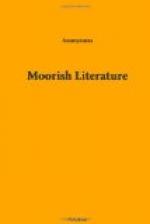“We will come aboard by force,” he was answered, and the attack began. One of the Christians killed a native with a gun. Then they fought until the Christians were overcome. Two Christians were killed and the rest captured and taken ashore and imprisoned with the others of the water-party. The ship was sold for 180 mithkals. The Christians were all sold and dispersed among the tribes. The news of this spread to Taccourt. The merchants there sent to Ait-Bamouran and bought all the Christians at any price. They secured seven. Three were missing, of whom two were in the country of Ait-bou-Bekr with the chief of that tribe named Abd-Allah, son of Bou-Bekr. The third, who was a boy, was with the sheik of Aglou, who said:
“I will not sell this one, for he has become as dear to me as a son.” Then addressing the young boy he said, “I wish to convert you; be a Mussulman.” The boy acquiesced and embraced Islamism. The day of his abjuration the sheik killed in his honor an ox for a festival, and gave to the convert the name of Mahomet. Then he sent to say to all his tribe:
“Come to my house. I have prepared a repast.” The Mussulmans came and diverted themselves with their horses and gunpowder. The chief told them, “I have given a fourth of my possessions, a slave, and a servant to this young man.” He added, “He shall live with my son.” They both occupied the same room, and the master taught the young convert the whole Koran. The Mussulmans called him Sidi Mahomet, son of AH. Seven Christians were ransomed and sent back to their own country.
VI
Information about the country Tiznit: This place is a kind of a city surrounded on all sides by a wall, and having only two gates. The water is in the centre, in a fountain. The fortress is built above the fountain, in the middle of the city. It is entirely constructed of mortar, cut stone, marble, and beams, all from Christian countries. It was the residence of the khalifah of the King in the time of Mouley-Soliman. When this prince died, the people of Tiznit revolted, drove away the lieutenant, and made a concerted attack upon the citadel, which they completely destroyed. They took the stones and beams and built a mosque on the spot, near the fountain of which we have spoken. But when Mouley-Abd-Er-Rahman came to the throne he sent a caliph to Tiznit. He gave him 300 horsemen. When the caliph arrived near the town he waited three days and they gave him food and barley. At the end of this time he made a proclamation summoning all the people to him. When they came he read them the royal edict and said:
“I must enter your city to occupy the fortress of the King!” They said: “No; go back whence you came and say to your master: ’You shall not rule over us. Your fortress is totally destroyed, and with the material we have built a big mosque in the middle of our city.’”




